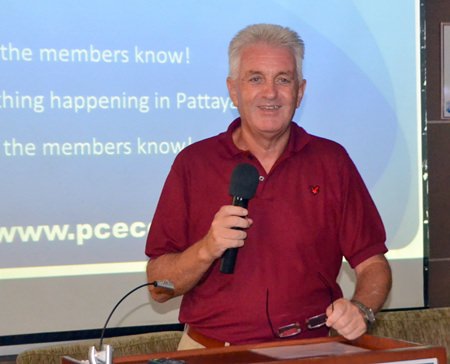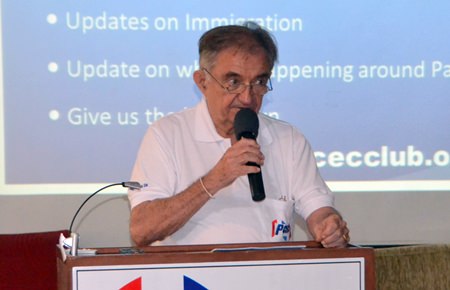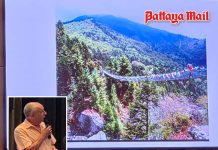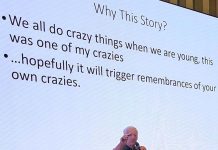“It’s the most purely Thai thing I’ve ever been to,” said Pattaya City Expats Club member Ren Lexander, speaking of the trip that the PCEC recently facilitated to Loei Province in Northeast Thailand. Ren said there were thousands of Thai people at the Pii Taa Kon Festival, but only about 15 foreigners – and 12 of them were on the tour with Ren. Ren and fellow PCEC member Pasit Foobunma were the guest speakers at the August 2 PCEC meeting. Ren showed slides and videos, while Pasit gave Thai cultural aspects of the colorful festival.
Tourism Authority of Thailand describes the festival this way: The whole event is called Bun Luang, and the great highlight of this unique festival is a long, colorful parade of young men who dance and strike poses while wearing huge masks made from carved coconut-tree trunks, topped with wicker work and sticky-rice steamers. These represent ghosts and as they parade they carry a sacred Buddha image. It is thought that the festival originated as a form of spirit worship with music and dancing to appease the spirits who protect the local villages and ensure plenty of rain for the upcoming harvest season. – Source: http://www.tatnews.org/ai1ec_ event/phi-ta-khon-and-bun-luang-festival-2015/#sthash.TYQ4ccPJ.dpuf
 Ren Lexander describes to his PCEC audience the Pii Taa Kon as a very Thai Festival involving a procession of many villages in the area wearing “ghost masks” or dressed in garb typical of their village.
Ren Lexander describes to his PCEC audience the Pii Taa Kon as a very Thai Festival involving a procession of many villages in the area wearing “ghost masks” or dressed in garb typical of their village.
Although the festival is commonly referred to as the Festival of Ghost Masks, Ren said he learned that the literal translation of “Pii Taa Kon” is “ghosts following people.” Pasit said the festival celebrates the return of Prince Vessandorn (the last incarnation before he incarnated as Siddhartha Gautama and became The Buddha) after a long banishment from his father’s kingdom because he gave away a royal white elephant. When the Prince finally arrived his subjects were so happy they ran forth to welcome him joyously. The welcome became a celebration and the celebration became so noisy that it awakened the dead … so the dead came to join the party.
According to Ren, the colorful, noisy procession is very village oriented – each village has a group of people who wear costumes and the huge masks and perform various dances and other antics to traditional Thai music. “There’s a new sound coming down the street every few minutes,” he said.
In addition to the human performers, another popular sight in the procession is water buffalos, which in days before mechanization served as tractors in the rice fields. Pasit said the buffalo is a symbol of how rich and green the village is, and is also believed to bring good luck.
 Pasit Foobunma shows the typical style houses of the Tai Dam hill tribe they visited during their tour while commenting on some of the tribe’s culture.
Pasit Foobunma shows the typical style houses of the Tai Dam hill tribe they visited during their tour while commenting on some of the tribe’s culture.
The procession ends up at the Wat (Buddhist temple) where prizes are given for the best village entries among much merriment. Ren showed a photo of a large hole in the floor of the Wat, designed so that the Naga (a giant mythical serpent believed to live in the Laotian stretch of the Mekong River) can enter. Pasit explained that the Thai people believe the Naga brings wealth and rain to the fertile land.
After passively watching the procession from the side of the road for some time, Ren and some others in the tour group noticed that many Thai onlookers were jumping into the procession to take close-up photos with the costumed marchers. “So we decided to join them,” he said. The result was a series of interesting views of the festivities.
 Ren Lexander showed this photograph of some of the participants in the Pii Taa Kon Festival procession wearing their very colorful masks.
Ren Lexander showed this photograph of some of the participants in the Pii Taa Kon Festival procession wearing their very colorful masks.
In addition to the Pii Taa Kon Festival, the group also visited other parts of Loei Province during their three-day trip. Ren and Pasit noted how green and clean everything is; they didn’t even see any garbage on the side of the road. One of their visits was to a village of the Tai Dam tribe. The word “dam” means “black” in Thai, and the tribe is so named because they wear primarily black clothes. The men wear black shirts with ornate silver buttons to show how wealthy they are; the more buttons, the richer they are. The tribe members did a Tai Dam dance for the group, and showed how the women wrap their hair: depending on the placement of the knot on her head, it indicates if she is married or not. The Tai Dam live in small bamboo houses on stilts with thatched roofs. Symbols protruding from the rooftops designate the status of the occupants. A large water wheel is used to move water from one rice paddy to another.
 This photograph taken by Ren Lexander shows two young ladies wearing their native dress from one of the village groups participating in the Pii Taa Kon Festival.
This photograph taken by Ren Lexander shows two young ladies wearing their native dress from one of the village groups participating in the Pii Taa Kon Festival.
After the presentation MC Roy Albiston brought everyone up to date on upcoming events and called on Judith Edmonds to conduct the Open Forum, where questions are asked and answered about Expat living in Thailand, especially Pattaya.
For more information on the PCEC’s many activities, visit their website at www.pcecclub.org.




